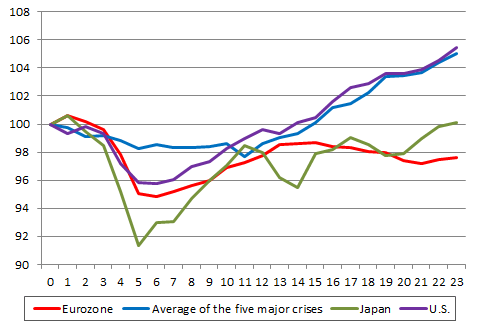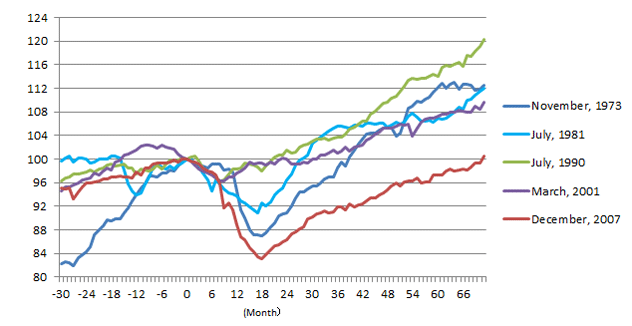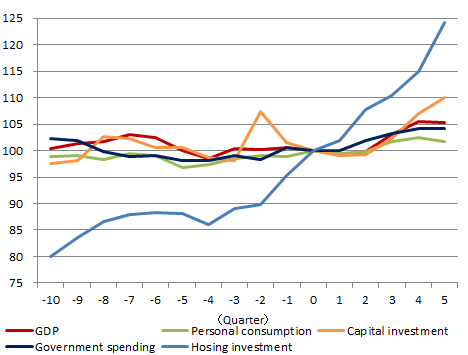The global economy is slowly recovering, but among the developed economies, while the United States is recovering from the collapse of the subprime mortgage bubble and Japan is steadily growing due to the effects of Abenomics, the eurozone countries are sluggish. As more than five years have passed since the collapse of Lehman Brothers, I would like to review the changes in these three economies, and then provide the economic outlook for 2014.
Economic recovery slower than that experienced in the five major crises
Reinhart & Rogoff (Note 1) refer to the financial crises experienced in Spain (1977), Norway (1987), Finland (1991), Sweden (1991), and Japan (1992) as the five major crises. They demonstrated that, after a serious financial crisis, growth rates do not recover to the pre-crisis level for more than three years. The International Monetary Fund's (IMF) report in April 2009 (Note 2), which indicated the possibility that the global financial crisis after the collapse of Lehman Brothers could be serious, actually followed Reinhart & Rogoff's argument on the five major financial crises, demonstrating that the crises were followed by economic recessions lasting for approximately seven quarters, and that it took more than six quarters additionally for the gross domestic product (GDP) to recover to the level of the previous economic peak.
Figure 1 indicates the changes in the economies of Japan, the United States, and the eurozone after the Lehman Brothers bankruptcy in comparison to the five major crises—which demonstrate that the economies of these developed countries following the aftermath have been slow even in comparison to the economies after the five major crises which faced extremely serious recessions and experienced only a gradual recovery. Even the strongest recovery, which was experienced by the U.S. economy, is only comparable to the trend following the five major crises. The Japanese and eurozone economies have been conspicuously sluggish.

What is striking is not merely their weak recoveries. Japan and the eurozone experienced multiple downturns in a period of a little over five years. While the United States has seen a downturn only once, the eurozone and Japan have had two and three downturns, respectively. The first recession for all three economies was the downturn immediately following the Lehman Brothers bankruptcy. Following this, the serious euro crisis occurred in the eurozone. For Japan, the Great East Japan Earthquake affected its economy, and subsequently the significant appreciation of the yen and the slowdown of overseas economies put further downward pressure on it.
What caused the economic downturns?
The demand components that caused the downturns in the process of economic recovery in Japan, the United States, and the eurozone can be identified by comparing the trends in various components in each country's and region's economic cycles in the past. In the United States, while all of the major economic indicators have recovered only slowly, personal consumption has been relatively strong and has led the recovery. Against the backdrop of such strength were an income tax reduction and proactive monetary easing measures which led to the appreciation of stock prices and the recovery of housing prices. Furthermore, it can be noted that, although the unemployment rate remains high, the pace of improvement in the unemployment rate has been comparable to that seen in past economic recovery periods.
On the other hand, the recovery of industrial production was slow. It was only in November 2013 that the production level returned to the level seen at the economic peak prior to the Lehman Brothers collapse. (Figure 2) While reshoring of the manufacturing industry is attracting attention, its production and employment levels indicate that only such sectors as automobiles and automobile components, computer/electronics/semiconductor-related, and oil and coal production are significantly recovering from the downturns, however, there has been no comprehensive recovery of the entire industry.

In the eurozone, investment and consumption have declined, and gross fixed capital formation in particular has seriously decreased. These have resulted from the euro crisis which constrained liquidity in the region's countries hit by debt crises and from the decrease in investment and consumption as fiscal consolidation was prioritized. Other factors include the structure of the eurozone where, while foreign exchange rate adjustments cannot occur within the zone, the recovery of competitiveness to Germany, the sole winner in the zone, can be brought about only by decreases in wages and prices.
Japan has been recovering rapidly since 2013 due to the effects of Abenomics after facing completely stagnant internal and external demands. An analysis of components indicates that, contrary to expectations, personal consumption, which is leading the recent economic recovery, has not grown more than that seen in past economic cycles. (Figure 3) Rather, capital investment, which has seen slow recovery recently, is demonstrating its strength compared to the past.

As Figure 3 indicates, housing investment shows conspicuous upward fluctuation, in the backdrop of robust financial policies as well as the effect of demand brought forward before the increase in the consumption tax rate. Strong housing investment is expected to continue into 2014, as the aggressive monetary easing policy will continue, and the real interest rate, which has turned negative after a period of time, will affect housing investment significantly together with capital investment.
The Japanese economy's upward momentum will be sustained
The Japanese and eurozone economies have experienced significantly weak recoveries since the Lehman Brothers bankruptcy due to a series of significant shocks in the past five years. However, this indicates that the elimination of the causes of economic downturns in Japan and the eurozone would strongly drive their economies back toward growth paths.
Ending the euro crisis would eliminate such negative causes in the eurozone. The panacea for this economic disease, however, would require Greece and other countries in the zone that were hit by debt crises to improve their repayment capacity and limit the increase in public deficits, for which certain levels of economic growth led by the private sector are essential. The countries facing debt crises have fallen into deflation, which is rapidly expanding the gap in price increase rates and decreasing the gap in price competitiveness between these countries and Germany. However, the correction phase is far from quieting down and will continue in 2014, which indicates that economic conditions will continue to be severe in such countries as Greece, Portugal, and Spain.
In Japan, on the other hand, restoration from the earthquake is making progress although it is not in full scale. The excessive appreciation of the yen, which was one of the major causes of the recent economic downturn, has been corrected. Furthermore, considering that the U.S. Federal Reserve Board (FRB) has begun to taper quantitative easing and the Bank of Japan (BOJ) is continuing its robust monetary easing policy, the depreciation of the yen seems likely to continue in 2014. The synergistic effect of the recovery of the global economy, while still gradual, coupled with the yen depreciation will positively contribute to Japan's economic growth. Although there is downward pressure from the increase in the consumption tax rate, the upward momentum of the Japanese economy, unlike the eurozone economy, is expected to be sustained in 2014.

